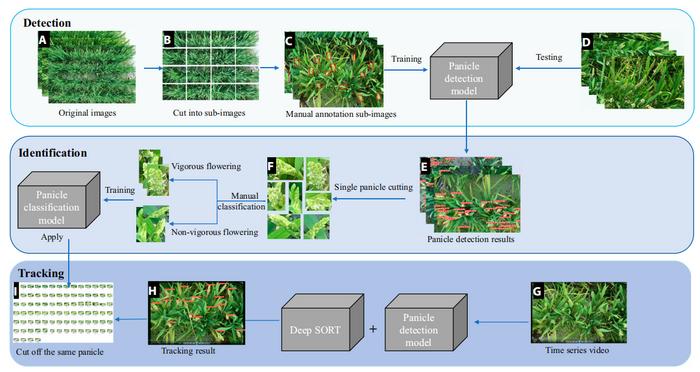TL;DR:
- Recent advancements in deep learning techniques, including YOLO v5 and ResNet50, have enhanced rice panicle analysis.
- A pipeline combining these models enables the accurate extraction of panicle traits from time-series images.
- The study demonstrates high accuracy in panicle counting and precise estimation of heading dates under varying nitrogen treatments.
- Increased nitrogen leads to more panicles, longer flowering durations, and earlier flowering initiation.
- The models effectively detect panicles with varying shapes, colors, and textures.
- This approach aids in understanding rice flowering processes, heading dates, and their sensitivity to environmental factors.
- Higher nitrogen application accelerates flowering initiation and extends flowering periods.
- The method exhibits robust performance in tracking rice panicles, even in changing environmental conditions.
- The study highlights the impact of nitrogen on rice heading, flowering, and grain filling initiation and duration.
- This innovative pipeline offers a non-destructive, precise, and efficient way to obtain panicle traits for agronomic research and cultivation practices.
Main AI News:
Rice is undeniably a linchpin of global food security, nourishing half of the world’s populace. Its cultivation, notably influenced by environmental dynamics during the heading-flowering phase, holds sway over pivotal growth attributes. Traditional phenotyping techniques fall short when dealing with large-scale scrutiny, necessitating the implementation of advanced, precise surveillance solutions. Recent strides in computer vision and machine learning, chiefly the realm of deep learning, have substantially elevated the field of plant phenotyping.
Methods like the Scale-Invariant Feature Transform (SIFT) algorithm and Convolutional Neural Networks (CNNs) have greatly enhanced our understanding of rice panicle analysis. Nevertheless, these methods have faced constraints in capturing the intricate, time-dependent growth patterns of rice panicles. Addressing this lacuna demands the fusion of field cameras with deep learning methodologies, ushering in an era of comprehensive real-time monitoring.
In June 2023, the prestigious journal Plant Phenomics unveiled a groundbreaking research article titled “Analyzing Nitrogen Effects on Rice Panicle Development through Panicle Detection and Time-Series Tracking.”
This pioneering study unveiled a meticulously designed pipeline, harnessing the prowess of YOLO v5, ResNet50, and DeepSORT models to autonomously extract intricate panicle characteristics from time-lapse imagery. The efficacy of this method was rigorously tested in discerning subtle disparities in panicle development across diverse nitrogen treatments. The results were nothing short of remarkable, exhibiting exemplary precision in panicle quantification (R2 = 0.96, RMSE = 1.73) and a near-perfect estimation of the heading date (absolute error of 0.25 days).
Moreover, this methodology facilitated the dissection of flowering duration and the precise timing of individual panicle blossoms. This analytical prowess unveiled that heightened nitrogen levels corresponded to an increase in panicle numbers, extended flowering durations, and earlier initiation of flowering. Notably, the panicle detection model exhibited unwavering accuracy when subjected to various nitrogen treatments, affirming its applicability across a spectrum of rice varieties. It also adeptly distinguished between robust and lackluster flowering panicles, demonstrating impeccable precision. This study revolutionized our comprehension of the rice flowering process and heading date determination, aligning closely with manual tallies and on-ground observations.
Furthermore, this methodology adroitly pinpointed subtle flowering alterations attributable to environmental variables such as temperature and humidity. The meticulous tracking of individual panicles unveiled that heightened nitrogen application led to an earlier onset of flowering and prolonged flowering phases. Impressively, the model exhibited steadfast performance in tracking rice panicles, with a staggering 70% of panicles tracked continuously and comprehensively, even in the face of fluctuating environmental conditions. The study also cast a spotlight on the profound influence of nitrogen on rice heading and flowering, hinting at potential ramifications on grain filling. It was discerned that nitrogen application not only bolstered panicle numbers but also exerted a discernible influence on grain filling initiation and duration.
Conclusion:
The integration of deep learning models into rice phenotyping offers promising opportunities for the agricultural market. It allows for more efficient and accurate analysis of rice growth and nitrogen effects, potentially leading to improved crop management and yield optimization. This innovation aligns with the increasing demand for sustainable and data-driven agriculture, making it a valuable asset for farmers and researchers in the field.

